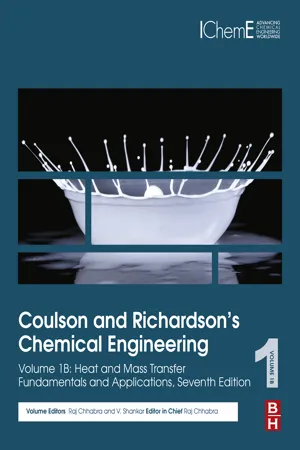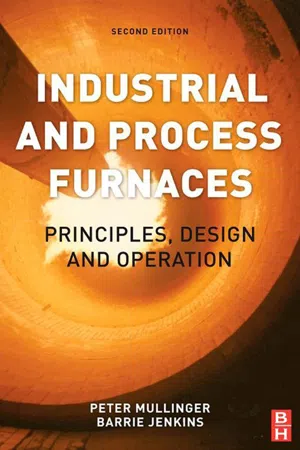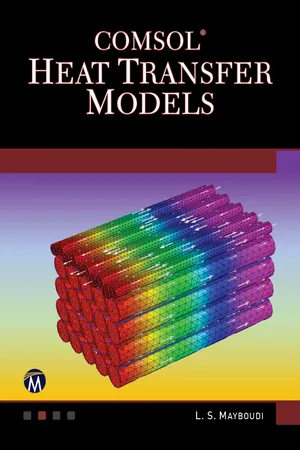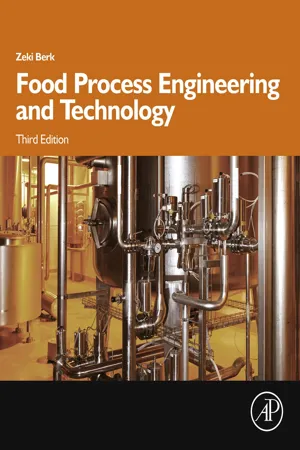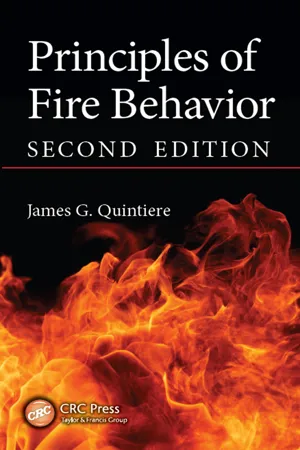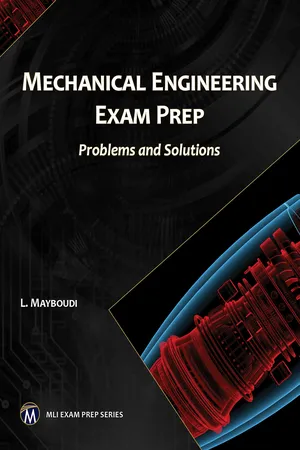Physics
Heat Transfer Efficiency
Heat transfer efficiency refers to the effectiveness of transferring thermal energy from one system to another. It is a measure of how much of the input energy is successfully transferred as useful heat. Factors such as insulation, material conductivity, and design play a crucial role in determining the efficiency of heat transfer processes.
Written by Perlego with AI-assistance
Related key terms
Related key terms
1 of 4
Related key terms
1 of 3
9 Key excerpts on "Heat Transfer Efficiency"
- eBook - ePub
Fluid and Thermal Dynamics Answer Bank for Engineers
The Concise Guide with Formulas and Principles for Students and Professionals
- Ethirajan Rathakrishnan(Author)
- 2023(Publication Date)
- BrownWalker Press(Publisher)
Chapter 7
Heat Transfer
7.1Basic Concepts and Definitions
Heat transfer is the science of energy in transit due to a temperature difference.In a heat transfer process,• Conduction is an energy transfer process from more energetic particles of a substance to the adjacent, less energetic ones as a result of the interaction between the particles.• Convection is the mode of heat transfer between a solid surface and the adjacent liquid or gas that is in motion.• Radiation is the heat transfer mode in which the energy is emitted by matter in the form of electromagnetic waves (or photons) as a result of the changes in the electronic configurations of the atoms or molecules.Any physical quantity can be characterized by dimensions . The magnitudes assigned to the dimensions are called units . The law of dimensional homogeneity states that, an analytically derived equation representing a physical phenomenon must be valid for all systems of units.System is an identified quantity of matter or an identified region in space chosen for a study. The region outside the system is called surrounding . The real or imaginary surface that separates the system from its surroundings is called the boundary . A closed system (control mass) consists of a fixed amount of mass (say a gas mass), and no mass can cross its boundary. Mass cannot cross the boundaries of a closed system, but energy can cross the boundaries. Isolated system is a special case of closed system where even energy is not allowed to cross the boundary. An open system (control volume) is a properly selected region in space, which may change its position and mass can enter and leave the region, but the size and shape of the system will remain invariant.Energy can exist in numerous forms, such as chemical, electrical, kinetic, potential, mechanical, thermal, and nuclear, and their sum constitutes the total energy of a system. The total energy of a system per unit mass is termed specific energy . The macroscopic energies are those a system possesses as a whole, with respect to some outside reference frame, such as kinetic energy and potential energy. The microscopic forms of energy are those related to the molecular structure of a system and the degree of the molecular activity, and they are independent of outside reference frames. The sum of all the microscopic forms of energy is called the internal energy of a system. The energy that a system possesses as a result of its motion relative to some reference frame is called the kinetic energy . The potential energy - eBook - ePub
- British Gas(Author)
- 2014(Publication Date)
- Routledge(Publisher)
Heat is energy in transition under the motive force of a temperature difference, and the study of heat transfer deals with the rate at which such energy is transferred. In thermodynamic analyses ideal processes can be conceived during which heat is transferred by virtue of an infinitesimally small temperature difference, without regard to time as a limiting factor. In actual processes some of the available temperature drop, which might be used for the production of work, must be sacrificed to ensure that the required quantity of heat is transferred in a reasonable time across a surface of practicable size. Two broad types of problem are frequently of interest to engineers: the first, met in the design of boilers, heat exchangers and other plant, is concerned with the promotion of the required rate of heat transfer with the minimum possible surface area and temperature difference. The other is concerned with the prevention of heat transfer, i.e. with thermal insulation.Before considering the various mechanisms by which heat is transferred it is necessary to understand the different ways in which substances are made up from the constituent atoms or molecules. The phases of pure substances (solids, liquids and gases) are associated very closely with the internal energy of the substance.For the same substance in its various phases, the various thermal properties — specific heat capacity, conductivity etc — will have values of different orders of magnitude. The specific heat capacity of a solid is generally very low, for a liquid it is comparatively high, while a gas usually has an intermediate value. In addition, any change of phase will involve a large amount of energy, often termed latent heat (fusion, vaporisation or sublimation) as shown in Figure 5.1 for the heating of liquid water to steam. Therefore, whenever a body is absorbing or losing heat, special consideration must be given as to whether the change is one of sensible heat, latent heat, or a combination of the two.5.1.1 Mechan isms of Heat Transfer
There are three modes of heat transfer: conduction, convection and radiation.Fig. 5.1 Sensible and latent heating of water - eBook - ePub
Coulson and Richardson's Chemical Engineering
Volume 1B: Heat and Mass Transfer: Fundamentals and Applications
- R. P. Chhabra, V. Shankar(Authors)
- 2017(Publication Date)
- Butterworth-Heinemann(Publisher)
Chapter 1Heat Transfer
Abstract
In most of the chemical processes, heat is either absorbed or given out. Heat transfer takes place through conduction, convection, or radiation. A major problem in heat transfer is transferring it at a desired rate. It is necessary to prevent the loss of heat during transfer in many systems such as food storage and preservation, cooling of electronic components, thermal efficiency of buildings, energy production and storage devices, and biomedical related applications.Keywords
Heat transfer; Mean temperature difference; Conduction; Heat exchangers; Convection; Radiation1.1 Introduction
In the majority of chemical processes heat is either given out or absorbed, and fluids must often be either heated or cooled in a wide range of plant, such as furnaces, evaporators, distillation units, dryers, and reaction vessels where one of the major problems is that of transferring heat at the desired rate. In addition, it may be necessary to prevent the loss of heat from a hot vessel or pipe system. Additional examples are found in the context of food storage and preservation, cooling of electronic components, thermal efficiency of buildings, energy production and storage devices, biomedical related applications, etc. The control of the flow of heat at the desired rate forms one of the most important areas of chemical engineering. Provided that a temperature difference exists between two parts of a system, heat transfer will take place in one or more of three different ways.Conduction . In a solid or in a stagnant fluid medium, the flow of heat by conduction is the result of the transfer of vibrational energy from one molecule to another, and in fluids it occurs in addition as a result of the transfer of kinetic energy. Heat transfer by conduction may also arise from the movement of free electrons, a process, which is particularly important with metals and accounts for their high thermal conductivities.Convection . Heat transfer by convection arises from the bulk flow and mixing of elements of fluid. If this mixing occurs as a result of density differences as, for example, when a pool of liquid is heated from below, the process is known as natural - eBook - ePub
Industrial and Process Furnaces
Principles, Design and Operation
- Barrie Jenkins, Peter Mullinger(Authors)
- 2013(Publication Date)
- Butterworth-Heinemann(Publisher)
The primary objective of a furnace is to transfer thermal energy to the product, thus before we analyse or design any combustion process equipment we must have a comprehensive knowledge of the fundamentals of heat transfer. If there is a temperature difference (i.e. a driving force) between two parts of a system, then heat will be transferred by one or more of three methods.Conduction In a solid, the flow of heat by conduction is the result of the transfer of vibrational energy from one molecule to the next, and in fluids it occurs in addition as a result of the transfer of kinetic energy. Conduction may also be created from the movement of free electrons (viz. metals).Convection Heat transfer by convection is attributable to macroscopic motion of a fluid and is thus confined to liquids and gases. Natural convection arises from density differences caused by temperature gradients in the system. Forced convection occurs due to eddy currents in a fluid in turbulent motion.Radiation All materials radiate thermal energy in the form of electromagnetic waves. When radiation falls on a surface it may be reflected, transmitted, or absorbed. The fraction of energy that is absorbed is manifest as heat.We can write a general equation for the heat transfer rate between two parts of a system (net heat flux) as:(4.1)The origin of Φ and the value of n vary according to the mode of heat transferΦ n Conduction kA /x 1 Convection hA 1 Radiation σεA 4 During convective heat transfer, chemical reactions sometimes occur concurrently at the interface (surface), and in these cases the enthalpy difference is used in place of the temperature difference to account for both sensible and chemical energy components.4.1 Conduction
When considering conduction, we can rewrite equation 4.1 more correctly as(4.2)This is the classical Fourier equation, and can be used to analyse two scenarios:• steady state conduction −∂t/∂x is independent of time θ• transient conduction −∂t/∂x depends on time θ4.1.1 Steady State Conduction
Under these conditions, the temperature gradient through the system remains constant. Thus equation 4.2 - eBook - ePub
- Layla S. Mayboudi(Author)
- 2019(Publication Date)
- Mercury Learning and Information(Publisher)
Heat transfer occurs from the point of higher temperature to that of the lower one, until the temperature equalizes among all regions and the rate of heat transfer approaches zero, reaching the state of thermal equilibrium. If there are also no internal forces due to thermal effects in any part of the system (mechanical equilibrium), no chemical reactions or movement of reactants (chemical equilibrium), and no temperature difference between the surroundings and system (thermal equilibrium), thermodynamic equilibrium is reached. In this condition, no spontaneous change occurs. 3.3.1 Conduction Heat Transfer Temperature difference is the driving force for the movement of heat energy; heat is transferred from the location with a higher temperature to that with a lower one. This heat flow rate (q in W = J/s) depends on the heat conduction coefficient (k in W/mK), which is the proportionality factor, area of the body normal to the heat flow (A in m 2), and temperature change (dT in K) with respect to the distance (dx in m). This is described by Fourier’s equation— q = − kA (dT / dx). Thermal conductivity depends on the material and demonstrates how fast the molecules get excited and show signs of increased activity as temperature increases. Metals have higher thermal conductivity compared to nonmetals. The closer the molecules are to one another, the easier it is for them to transfer their motion, which corresponds to thermal energy. The heat conduction transfer direction is along the direction of the temperature gradient. Temperature gradient is a vector. For three-dimensional space, each of the vector’s three components is obtained by calculating the derivative of temperature with respect to the distance along that component. Thus, a vector (dT / dx, dT / dy, dT / dz) is obtained in Cartesian coordinates. The area that is normal to the heat transfer gradient vector is considered when calculating the total power passing through a plane - eBook - ePub
- Zeki Berk(Author)
- 2018(Publication Date)
- Academic Press(Publisher)
F = 0.It is sometimes convenient to decompose the complex notion of resistance to its physical components. Thus, as the rate of transport can logically be expected to be proportional to the area A available to the transport, it is often customary to deal with the rate of transport per unit area . This dimension is known as flux and denoted by the symbol J.3.2.2 Mechanisms of Heat and Mass Transfer
Heat transfer occurs via three fundamental mechanisms: conduction , convection , and radiation (McAdams, 1954 ).Conduction refers to the transfer of heat through a stationary medium. The mass transfer equivalent of conduction (conductive mass transfer) is molecular diffusion through a stationary medium.Convection occurs when heat travels along with a moving fluid. In mass transfer, convection (convective mass transfer ) refers to a situation whereby molecular diffusion occurs simultaneously with bulk flow.Radiation is the transfer of heat in the form of electromagnetic energy. Unlike the former two mechanisms, radiative heat transfer does not require the presence of a material medium between the two points.In practice, more than one mechanism may be involved in a transfer process.3.3 Conductive Heat and Mass Transfer
3.3.1 The Fourier and Fick Laws
In media with no considerable internal mobility (e.g., solids), heat travels by conduction and mass travels by molecular diffusion. These transfers are governed by Fourier's and Fick's laws, respectively.For heat transfer:dQ Adt= − k∂ T∂ zFourier 's 1 st Law(after Jean-Baptiste Joseph Fourier, French mathematician-physicist, 1768–1830). For mass transfer:(3.2)=dm BAdtJ B= −D B∂C B∂ zFick 's 1 st Law(after Adolf Eugen Fick, German physiologist, 1829–1901). where:(3.3)Q = heat transferred (J).T = temperature (K).t = time (s).k = thermal conductivity of the medium (J s− 1 m− 2 K− 1 m = W m− 1 K− 1 ).z - eBook - ePub
- James G. Quintiere(Author)
- 2016(Publication Date)
- CRC Press(Publisher)
3 Heat Transfer Learning Objectives Upon completion of this chapter, you should be able to • Describe the difference between energy and heat • Explain conduction, convection, and radiation heat transfer • Describe the concept of heat flux and its significance to hazards from fire • Perform simple computations in heat transfer 3.1 Introduction Although chemistry and fluid mechanics are important in the study of fire, we can forgo their study for elementary quantitative purposes here. Fluid flow is important to know how air enters a flame and how smoke travels in a building. Mostly, this flow is due to buoyancy created by the fire and hot smoke itself. Wind is important for fires in the open, as in forest fires and conflagrations. In our study of fire plumes (Chapter 7) and compartment fires (Chapter 9), these aspects of fluid flow will be addressed. Of course, chemistry is important, as it is the basis of combustion. In the previous chapter, we have learned that chemical reaction takes place relatively fast, and therefore, as the fuel and oxygen burn, the reaction region is very thin. Often in even sophisticated analysis of flames, the actual chemical dynamics and reaction mechanisms can be ignored. An assumption for a flame of having zero thickness can suffice, and there the fuel and oxygen immediately become products of combustion. However, the importance of heat transfer cannot be avoided if we are to develop the ability to make quantitative analyses. Heat transfer causes the solid and liquid fuels to vaporize to produce the gaseous fuel for the flame. Heat transfer is responsible for making the fire move over surfaces and through the forest. Indeed, it is the dominant factor in determining the fate of fire growth and the damage it can produce - eBook - ePub
Infrared Thermal Imaging
Fundamentals, Research and Applications
- Michael Vollmer, Klaus-Peter Möllmann(Authors)
- 2017(Publication Date)
- Wiley-VCH(Publisher)
heat flow. In physics, one usually distinguishes three kinds of heat flow: conduction, convection, and radiation. As a matter of fact, the underlying physical processes for conduction and convection are very similar, so the distinction is rather artificial.4.2.1 Conduction
Conduction refers to the heat flow in a solid or fluid (liquid or gas) that is at rest (Figure 4.2 ). Conduction of heat within an object, for example, a wall of infinitesimally small thickness ds, is usually assumed to be proportional to the temperature difference dT on the two sides of the object as well as the surface area A of the object, and inversely proportional to the thickness ds of the sample, that is,(4.1a )For the specific example of a macroscopic one-dimensional (1D) wall of thickness s = s1 − s2 , steady-state conduction leads to a temperature that varies linearly with distance. In this case,(4.1b )In what follows, we mostly refer to the simplified heat conduction equation . The heat transfer coefficient is defined as αcond = λ/s, where λ is the thermal conductivity of the wall material given in W (m K)–1 and s is the wall thickness given in meters. (Note that λ uses the same Greek symbol that is usually reserved for wavelength. Rather than introducing additional subindices that would unnecessarily complicate the notation, in particular when later a distinction between thermal conductivities for different materials – indicated by subindices – will be made, we will stick with the same symbol since the context of the corresponding equations will usually make it clear which quantity – wavelength or thermal conductivity – is meant.) The heat transfer coefficient αcond describes heat transfer in watts per unit area and Kelvin, that is, W (m2 K)–1 . Hence, the heat flux through the wall in watts gives the energy flow per second through the wall of surface area A if the temperature difference between the inner and outer surfaces is given. Table 4.1 gives typical values of thermal conductivities of materials as well as their corresponding heat transfer coefficients for s - eBook - ePub
Mechanical Engineering Exam Prep
Problems and Solutions
- Layla S. Mayboudi, S. Musa, PhD(Authors)
- 2021(Publication Date)
- Mercury Learning and Information(Publisher)
7HEAT TRANSFER
- The main modes of heat transfer are: (a) conduction, convection, and radiation (b) convection and electromagnetism (c) dynamism and electromagnetism (d) conduction and convection
- Conduction heat transfer happens by means of: (a) electromagnetic waves (b) contact between surfaces (c) currents in a fluid (d) all of the above
- Convection heat transfer happens by means of: (a) electromagnetic waves (b) contact between surfaces (c) currents in a fluid (d) all of the above
- Radiation heat transfer happens by means of: (a) electromagnetic waves (b) contact between surfaces (c) currents in a fluid (d) all of the above
- If A is area, e is emissivity, and s is the Stefan-Boltzmann constant, Stefan-Boltzmann’s law states that Q = σεAT4 Q is:(a) light intensity emitted by the body (b) irradiation from a body (c) power radiated from a black body (d) reflected energy from a black body
- The convective heat transfer coefficient relates: (a) heat capacity to temperature variation (b) temperature to heat transfer flux (c) heat capacity to cross-sectional area variation (d) the difference between fluid and solid object temperature variations to heat transfer flux rate
- A black body with a rough surface absorbs heat . . . the one with a smooth surface:
Index pages curate the most relevant extracts from our library of academic textbooks. They’ve been created using an in-house natural language model (NLM), each adding context and meaning to key research topics.
Explore more topic indexes
Explore more topic indexes
1 of 6
Explore more topic indexes
1 of 4


